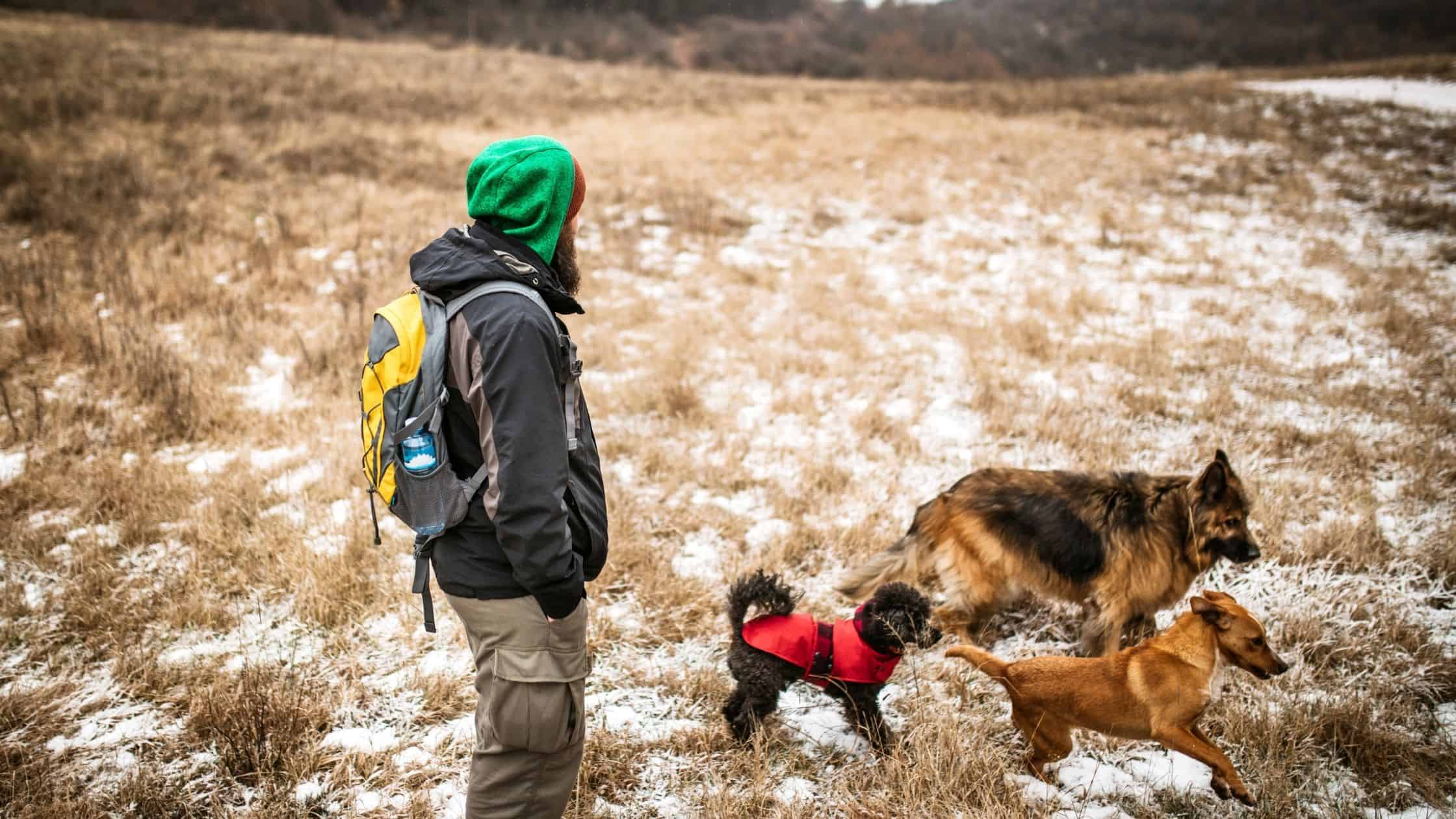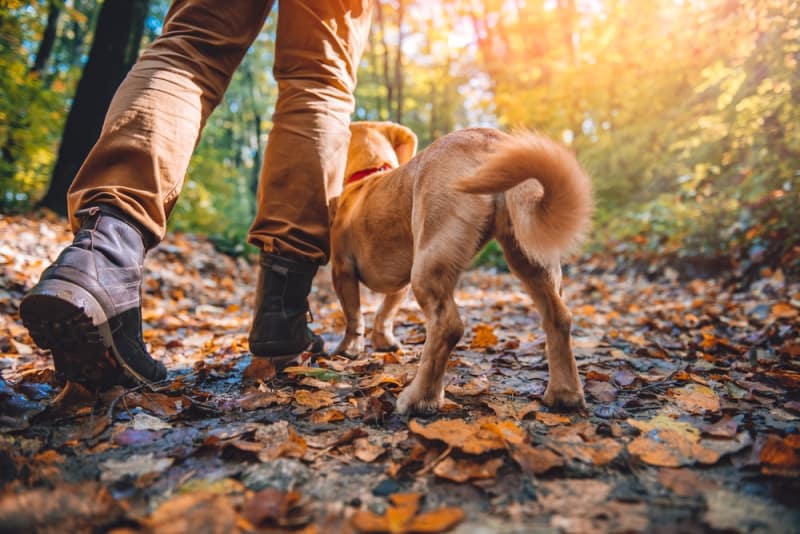7 Tips for Safely Hiking with Dogs

Outdoor hiking with your dog is a great workout for you both and can be tailored to your experience level. It also provides the mental stimulation your pup needs to thrive. The new sights, sounds, and smells pique your pup’s curiosity and allow them to connect with their natural instincts.
Hikes can also be an excellent way to strengthen your bond with your furry companion. You and your dog will tackle this new experience together, and provides an opportunity to practice and reinforce desired behaviors. An open, safe trail can be a beneficial setting to train your pup on recall and other commands, helping them become well-behaved and well-mannered pets.
Of course, preparing before you hit the trail is always advised. This includes being aware of how to prevent ticks on dogs during hikes and practicing Leave No Trace principles. These are important factors to consider when heading outdoors with your pet.
Below are some suggestions and factors to keep in mind that will enhance your hiking experience with your dog:
- Select a hiking trail that is suitable for dogs.
- Protect your dog from fleas and ticks by using medication or a collar.
- Carry a durable leash and a collar with updated tags.
- Remember to bring fresh water in a collapsible bowl or a pet-friendly water bottle.
- Do not overlook the importance of having dog waste bags.
- Consider providing your dog with booties for inclement weather or rough terrain.
- Keep a towel and a first aid kit readily available for your dog.
Before embarking on an outdoor adventure and commencing your hike, consider your canine companion’s well-being and physical condition. Select a suitable trail that accommodates both you and your dog. When researching potential trails, ensure that dogs are permitted and have a contingency plan by locating the nearest veterinarian in case of any emergencies.

1. Select a hiking trail that is suitable for dogs.
To prevent any potential disappointment, it is recommended that you conduct a basic online search to confirm that dogs are permitted at your chosen hiking spot. Although it may appear that most trails are dog-friendly, several national parks in the US have strict no-dog policies. If you are uncertain about your dog’s eligibility, it is recommended that you contact the park’s ranger station beforehand.
You may find out that your dog is only allowed in some designated areas. It is important to also consider the landscape and difficulty level of the hike. Numerous trails are categorized based on their length and ruggedness, providing guidance in selecting between a relaxed day hike or a more challenging adventure.
2. Keep fleas and ticks away by using medication or a collar
Canines are naturally inclined to sniff their surroundings, and if they possess a curious nature, they may venture off the beaten path to investigate plants, shrubs, or trees. However, this type of exploration poses a risk of encountering ticks and fleas.
Protecting your dog from parasites is crucial to preventing diseases like Lyme disease. A reliable method to lower the chances of infestation is to use medication such as Frontline, which repels ticks, or to provide a Seresto flea and tick collar. If your dog enjoys being in the water, it is essential to note that most collars are not waterproof. In such cases, it is recommended to apply preventive medication at least 24 hours before going on a hike to keep your dog safe and free from ticks.
We also recommend checking your dog for ticks after each hike and washing them with flea and tick shampoo, particularly if you reside in a region known for tick infestations. It is important to note that the type of ticks to be aware of may vary depending on your location, such as the American dog tick, brown dog tick, and deer tick.
If you do find a tick on your dog, it’s important to remove it quickly and safely. The Humane Society provides a guide for proper tick removal that can aid with the process. If you notice a tick bite on your dog’s skin, contact your veterinarian to discuss the next steps and whether it should be treated with antibiotics.
3. Remember to have a durable leash and collar with current identification tags
It is essential that your dog has a sturdy leash and collar. Many hiking trails require a non-retractable leash with a maximum length of six feet. This rule ensures that hikers can maintain complete control of their pets at all times. Additionally, your dog’s collar must have current tags with your name, phone number, rabies tag, and state registration information.
Proper trail etiquette involves following leash laws. This is especially crucial in areas with high foot traffic, as following this rule can ensure your dog’s safety and provide added protection for yourself and other hikers.
Remember, as dog owners, it is our responsibility to keep our pets from aggressive encounters with other dogs or wild animals and away from poisonous plants such as poison oak or ivy. If your dog is hiking off-leash, they should be able to walk calmly by your side and obey simple commands to create a much less stressful environment while hiking.
Keeping your dog on a leash during your hike is one of the best ways to ensure everyone on the trail stays safe.
4. Gather fresh water and a foldable bowl
Ensuring proper hydration for both you and your canine companion is crucial when tackling the trails. We’ve found the best way to give your dog water on a hike is using a collapsible dog bowl that ultimately does not take up a lot of space. If carrying an extra item like this is not feasible for you, consider dedicating a water bottle specifically for your dog to drink from during your adventure.
Be cautious about allowing your dog to consume water from ponds and lakes based on your location and the season. This is due to the presence of algae, which can be harmful. Additionally, stagnant water and puddles may harbor harmful bacteria thus, it is recommended to always provide fresh water for your canine companion
5. Remember to bring dog waste bags
It is important to maintain a clean and enjoyable hiking experience by properly disposing of your dog’s waste. To leave no trace, it is recommended to bring your own dog waste bags, double bag them, and carry them with you. This simple etiquette can prevent others from stepping in dog poop and preserve the natural environment.
This is because in areas with a lot of foot traffic, heaps of dog excrement can become excessively smelly, and the harmful microorganisms present can contaminate sources of freshwater. Additionally, this practice guarantees that other individuals who are hiking in the outdoors can also have a pleasant experience, just like you and your furry companions.
6. Provide dog booties during extreme temperatures or tough terrain
If you and your furry companion are the type to seek adventure and enjoy hiking in extreme weather conditions, such as cold winter days or hot summer months, dog booties may be helpful in keeping your dog’s paws safe. These boots, designed with waterproof materials and sturdy grip, offer a layer of defense and long-lasting durability. They can also be beneficial for traversing challenging landscapes or rough surfaces during your hikes.
7. Keep a towel and first aid kit handy
It is recommended that a pet first aid kit be readily available, containing essential items such as tweezers (for tick removal), gauze, tape, bandages, Benadryl, antiseptic wipes, and cotton swabs. Hopefully, you will not need to use it, but it’s best to be over-prepared rather than underprepared for an accident or emergency.

Final Thoughts
Aside from these quick tips on items you can bring with you on your hike, choosing a location with shade where you and your canine companion can take a break and cool off is crucial. Dogs get tired and can overheat just like we do. Therefore, it’s important to be mindful of the hiking conditions and your dog’s physical abilities.
Planning ahead and bringing necessary items for both you and your furry companion will make for a much better adventure with your pet. Not only will it provide ample exercise, but it will also create a memorable adventure for you and your dog.
To keep your pet healthy at home and on the go, get a free quote for Odie Pet Insurance!
Is your dog panting so much? Read this article to know more.
*Updated: May 9, 2024



